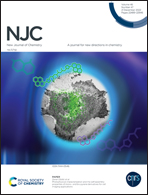A conjugated polymeric photocatalyst with a heterostructure and visible-light response for organic pollutant removal
Abstract
The design of organic photocatalysts with visible-light-response is an important way to solve energy crisis and environmental pollution. Polypyrrole (PPy) as one of the conjugated polymers is a prospective photocatalyst material due to its excellent optical properties, easy synthesis and high environmental stability. In this work, polyacrylonitrile (PAN) and g-C3N4 were electrospun as a fiber membrane matrix. PPy was coated on the matrix by in situ polymerization of a pyrrole monomer using doped Fe3+ as an oxidant. PPy exhibited a broadband visible light absorption region and a narrow band gap which was conducive to improve visible light utilization. The separation efficiency of photogenerated e−–h+ pairs was improved by constructing a heterojunction between PPy and g-C3N4. The doping of Fe3+ as an electron scavenger further prevented the recombination of carriers. The PAN/g-C3N4-PPy-Fe3+ membrane showed highly efficient removal performance for both cationic and anionic dyes. Moreover, PAN/g-C3N4-PPy-Fe3+ exhibited excellent recyclability and stability. This work outlined an approach for designing a novel conjugated polymer based multi-component composite photocatalyst with visible light response.



 Please wait while we load your content...
Please wait while we load your content...